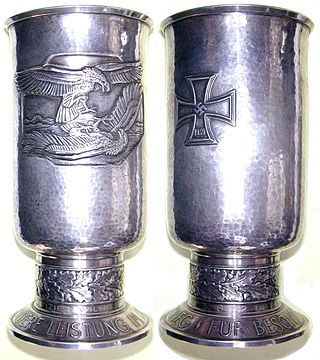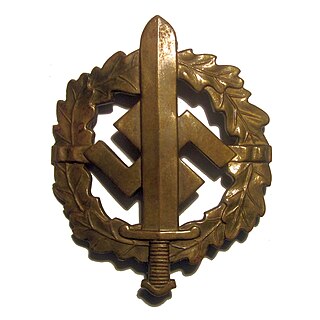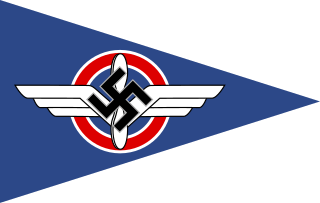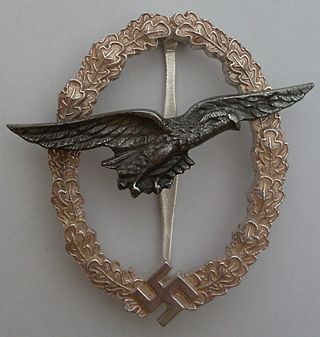An aviator badge is an insignia used in most of the world's militaries to designate those who have received training and qualification in military aviation. Also known as a pilot's badge, or pilot wings, the aviator badge was first conceived to recognize the training that military aviators receive, as well as provide a means to outwardly differentiate between military pilots and the “foot soldiers” of the regular ground forces.

Demyansk Shield was a World War II German military decoration awarded to Wehrmacht personnel who fought in the Demyansk pocket on the Eastern Front in the early months of 1942. The pocket of German troops had been encircled and cut off by the Red Army around Demyansk (Demjansk), south of Leningrad, and was successfully defended with the aid of an airbridge. The shield was instituted on 25 April 1943 by Adolf Hitler and was not bestowed after 1 July 1944.

The Kuban Shield was a World War II military decoration of Nazi Germany. It was awarded to Wehrmacht forces who fought at the Kuban bridgehead in the Soviet Union from February 1943 until it was abandoned in October 1943. The award was instituted on 21 September 1943.

The Narvik Shield was a World War II German military decoration awarded to all German forces that took part in the battles of Narvik between 9 April and 8 June 1940. It was instituted on 19 August 1940 by Adolf Hitler. The Oberkommando der Wehrmacht (OKW) published the order the same day. It was bestowed by General Eduard Dietl, the commander of Army Group Narvik.

The Ehrenpokal der Luftwaffe was a Luftwaffe award established on 27 February 1940 by Reichsmarschall Hermann Göring, the Reich Minister of Aviation and Commander-in-Chief of the Luftwaffe. It was officially known as the Ehrenpokal "für Besondere Leistung im Luftkrieg", or Honor Goblet "For Special Achievement in the Air War". The award was given only to flying personnel. Recipients' named were published in the periodical Ehrenliste der Deutschen Luftwaffe. German archives indicate that approximately 58,000 were given "on paper", but only 13–15,000 goblets were actually awarded according to the records. The first airman to receive the goblet was Oberstleutnant Johann Schalk on 21 August 1940.

The U-boat War Badge was a German war badge that was awarded to U-boat crew members during World War I and World War II.

The Front Flying Clasp of the Luftwaffe was a World War II German military decoration awarded to aircrew and certain other Luftwaffe personnel in recognition of the number of operational flights flown. It was instituted by Reichsmarschall Hermann Göring on 30 January 1941. It was awarded in Bronze, Silver, and Gold with an upgrade to include diamonds possible. Pennants suspended from the clasp indicated the number of missions obtained in a given type of aircraft. Front Flying Clasps were issued for missions completed in the following Luftwaffe aircraft:

The Parachutist Badge was a badge awarded to qualified parachutists of the Wehrmacht and the Waffen-SS of Nazi Germany.

The Pilot/Observer Badge was a World War II German military decoration awarded to Luftwaffe service personnel who had already been awarded the Pilot's Badge and Observer Badge. It was instituted on 26 March 1936 by the Commander in Chief of the Luftwaffe Hermann Göring. It was worn on the lower part of the left breast pocket of the service tunic, underneath the Iron Cross 1st Class if awarded. It was to replace the older 1933 Aircrew Badge.

The SA Sports Badge was a decoration of Nazi Germany that was issued between the years 1933 and 1945. It was a political version of the much more generic German Sports Badge, which was also issued in great numbers by the Nazis. At its center was a 57mm high Roman broad sword, superimposed over a Nazi swastika encircled by an wreath of oak leaves. It was a pin-back badge, but there was a cloth version, as well.

The German Air Sports Association was an organisation set up by the Nazi Party in March 1933 to establish a uniform basis for the training of military pilots. Its chairman was Hermann Göring and its vice-chairman Ernst Röhm.

Anti-Aircraft Flak Battle Badge was a World War II military decoration of Nazi Germany. It was instituted on 10 January 1941 by Hermann Göring in his capacity as the Commander in Chief of the Luftwaffe. The badge was awarded to servicemen of the Flak artillery who distinguished themselves in action against enemy aerial or ground attacks.
The Balloon Observer's Badge was a military decoration of Nazi Germany during World War II. It was awarded to German Army personnel who operated gas balloons flying them 300 ft (91 m)-500 ft (152 m) above the ground. The balloons were easy targets for Allied pilots and ground fire. Due to its late introduction, only a very small number of badges were awarded.

The Nazi Party Long Service Award, sometimes called the NSDAP Long Service Award, was a political award in the form of a badge of the Nazi Party.

The Army Anti-Aircraft Badge or Army Flak Badge was a German military decoration awarded to German Army personnel for service in an anti-aircraft battery during World War II. Designed by Wilhelm Ernst Peekhaus, it was of single piece construction. The pin back and clasp badge was grey metal in color. The badge was made in one grade; it had the national eagle at the top and an oak leaf wreath around the outside rim. In the middle was an 88 mm flak gun with the barrel facing upwards to the "viewer's" right.

The Radio Operator & Air Gunner's Badge is a commonly accepted title for the Luftwaffen-Fliegerschützen-Bordfunker-und Bordmechanikerabzeichen. It was a German military decoration awarded to radio operators, air gunners, and mechanics who were members of the German Air Force (Luftwaffe). This is given after they completed two months training or had taken part in at least five operational flights. If wounded during an operational flight, the badge could be awarded and worn earlier. Later in June 1942, a separate badge was introduced for air gunners and flight engineers. That badge had the same qualifications.

The Air Gunner's and Flight Engineer's badge was a German military decoration awarded to air gunners, mechanics or aircrew meteorologists who were members of the German Air Force (Luftwaffe) after they completed two months training or had taken part in at least five operational flights. If one was wounded during an operational flight, the badge could be awarded earlier. For Luftwaffe members who were air gunners and mechanics this badge replaced an earlier separate badge which had been introduced back in 1935. The qualifications for the two badges were the same for recipients.

The Flyer's Commemorative Badge was a German military decoration awarded to active and reserve personnel who had been honorably discharged from flying duties. Luftwaffe personnel qualified for the badge after having served as flyers for four years during World War I or had been honorably discharged after 15 years of flight duty service. However, one could also qualify for the badge if they became disabled due to a flying accident. If one was killed during the course of his flying duties, the badge was given to their next of kin. The badge is commonly known as the "Retired Aircrew Badge". It was awarded prior to 1 September 1939, the start of World War II in Europe. It is considered one of the most rare flying qualification awards.

The Glider Pilot's Badge was a German military decoration that was awarded during World War II to military pilot's who were members of the German Air Force (Luftwaffe) after they completed their glider training. Honorably discharged personnel who met the requirements could also be awarded the badge. A citation was issued with the awarded badge. It was worn on or right below the left breast tunic pocket.

The Observer's Badge was a German military decoration that was awarded before and during World War II to members of the German Air Force (Luftwaffe). They qualified for the badge after completing two months of qualifying service and five operational flights in the role of observer, navigator or bombardier; also, it could be awarded after a member of the German Air Force was wounded while acting in the capacity of an observer during a qualifying flight. It was worn on the left breast tunic pocket of an air force or political uniform tunic. A citation was issued with the awarded badge. Thereafter, Luftwaffe service personnel who had already been awarded the Pilot's Badge and Observer's Badge could qualify for the Pilot/Observer Badge. After 31 July 1944 the regulations were changed and the recipient had to have held both qualification certificates for at least one year to qualify for the Pilot/Observer Badge.

















